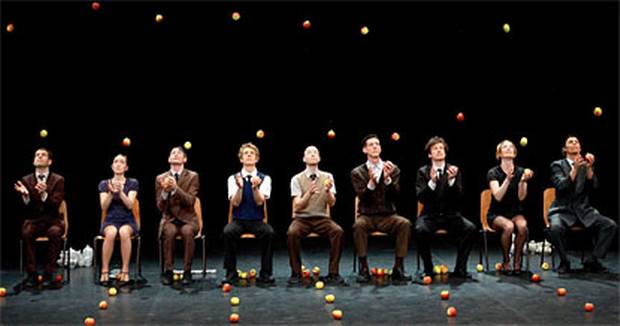Humorologie: Festival of Emotions, Belgium, 28th June, 2013
‘I never knew you could do so much with apples.’
This comment from our driver after tonight’s show seemed to sum up the reaction of the audience for London based Gandini Juggling‘s Belgian premiere at the Humorologie Festival in Marke-Kortrijk.
Using the skills of juggling (as the manipulation of objects through space via human bodies, which goes a great deal further than the familiar street-corner cascade), the 9 performers present an exploration of interaction that delves into our human struggles for control and desires for freedom.
Onto a stage marked by neat lines and symmetry, enter a brisk queue of performers, dressed in office-wear suggestive of the 1940’s. To an equally evocative soundtrack, they parade around the stage smiling at us with a winning geeky smugness, complete with silent-movie style eyebrow waggling, and perfectly synchronised juggling patterns. The eye-contact maintained with the audience throughout all the displays of juggling prowess is extraordinary; they love us, as every good clown should.
There are no red noses but, in the modern clowning tradition, the performers’ personal idiosyncrasies and vulnerabilities are on full display, often to great comic effect.
Despite a warm relationship with us, the show revolves around the difficulties the co-inhabitants of the onstage world face in their own attempts at interaction. The formalities of intricate – and deceptively simple – juggling patterns highlight the formalities in our social conventions, juxtaposed against our more animal disruptions in the face of sex, race, beauty, isolation and social ineptitude. Likewise, the absurdity of the postures and props highlights a ridiculousness in such behaviour.
 Under the direction of Sean Gandini and Kati Ylä-Hokkala, with dramaturgy by John-Paul Zaccarini, the production fuses movement styles in a choreography of bodies and objects to present a spectacle that incorporates dance, circus and drama in an anthropological study of societal behaviours and mating rituals.
Under the direction of Sean Gandini and Kati Ylä-Hokkala, with dramaturgy by John-Paul Zaccarini, the production fuses movement styles in a choreography of bodies and objects to present a spectacle that incorporates dance, circus and drama in an anthropological study of societal behaviours and mating rituals.
Visual surprises, such as the bizarre effect produced by a teacup passed behind the head of one performer, and playfulness (I particularly enjoyed the game of one performer disrupting his colleagues one by one as they juggled alone) keep the show engaging; the use of rhythm, both in the apples flying through the air, and in the sounds of footwork, breath and items hitting together, also creates an evolving dynamic.
The music is catchy and adds to the themes explored and, if I did get a little bored during a section where one of the female performers attempts a strange seduction of her male counterparts, the change in pace was well-timed and welcomed.
The show draws us to a final display of conformity and mannered restraint, where the initial lines of apples across the stage have been replaced by equally formulaic lines of china tea-set pieces; and then delivers a shock hit as the performers’ impulses are let loose, revealing a fearsome and ugly side to humanity under the decorum, amid real danger from flying shards of china.
The attempt to cover this darkness up again is not quite believable and this, I think, is the point.
Far more than ‘aw, juggling, how pretty’, ‘Smashed’ is a strong piece of contemporary theatre that just happens to use highly skilled object manipulation as the best way to transmit its message. Or is it a highly skilled juggling show which uses strong contemporary theatre as the best way to transmit its message?

